The requirements of a mixed construction fleet pose special challenges when installing a telematics solution
One of the best things about telematics is that it can deliver valuable data and insights to companies across a wide range of industries. But that’s doesn’t mean that one single telematics solution is necessarily the best bet for all industries. What might be the perfect telematics solution for a freight carrier that operates a fleet of over-the-road tractors and trailers won’t automatically be the right answer for a local HVAC company with a fleet of vans.
Then there’s construction, which is a different animal altogether. The “yellow beast” that is construction has telematics needs that are markedly different from other industries. One reason for this is that construction companies will need a tracking system for mixed fleets that include various types of vehicles and assets, ranging from pick-up trucks to yellow iron to portable equipment, such as generators or cranes.
In addition, construction also poses special challenges when it comes to telematics platform implementations. Let’s examine some of these challenges.
 There are the challenge of outfitting and connecting a mixed fleet. Given the combination of vehicles and assets that make up a construction fleet, the construction fleet management software will need to account for this diversity. Different types of telematics devices will be needed for a piece of equipment such as a backhoe, for which the company will want to track utilization, and a portable lighting unit, for which the company may just need to be able to track its location.
There are the challenge of outfitting and connecting a mixed fleet. Given the combination of vehicles and assets that make up a construction fleet, the construction fleet management software will need to account for this diversity. Different types of telematics devices will be needed for a piece of equipment such as a backhoe, for which the company will want to track utilization, and a portable lighting unit, for which the company may just need to be able to track its location.
And of course, these devices will have different requirements when it comes to their installation, ranging from simply affixing the device to the asset to wiring the device into the engine bus – a far more complicated install that requires the expertise of a professional installer.
There are special hardware needs. The telematics hardware installed on the various vehicles and assets in a fleet also need to be able to stand up to the tough jobsite conditions to which they will be exposed every day. A professional installer will be able to help identify the right devices that will be sufficiently rugged to handle the heavy use, dirt, and inclement weather that are the realities of construction. This need for heavy-duty telematics hardware is one of the biggest reasons why construction companies discover that solutions that might meet the needs of, say, a fleet of service vans, just won’t cut it for construction.
There are data needs that are unique to construction. Fleet utilization data is especially important to construction companies as they look to optimize efficiency, manage maintenance schedules to minimize downtime, accurately invoice for equipment use, and estimate future job costs. They also need to be able to track the location of assets so they can deploy them when and where they are needed.
These are different than the data needs of a transportation company that might be more interested in tracking driver behavior and compliance – another reason why it’s so important for construction companies to not be “oversold” by providers that specialize in other industries.
In the various telematics devices needed for a construction fleet, the focus should be on connecting everything into a telematics platform that can provide a single pane of glass view of the entire fleet. This can prove challenging, but if you have invested in the right fleet management software and are relying on knowledgeable, trained professional installers, there’s no reason it can’t be a reality.
A Difficult Yet Worthwhile Proposition
Your telematics solution provider needs to be a strategic business partner that can also provide expert installation. This is especially true in construction, where taming the yellow beast is a difficult proposition – but one that can provide huge benefits when it comes to operating, tracking and managing your mixed construction fleet more effectively.

